إذا كنت تعمل في فريق رشيق أنت تعرف مدى صعوبة الحصول على رؤية في الوقت الفعلي لتقدم المشروع وأداء الفريق.
فالمعركة ضد المعلومات المبعثرة عبر رسائل البريد الإلكتروني وجداول البيانات والاجتماعات حقيقية! فمع كثرة الاختلالات وإعادة العمل المتكررة، قد يكون من الصعب الحصول على تزامن جهودك مع أهداف الفريق.
توفر لوحات المعلومات الرشيقة تمثيلاً مركزيًا ومرئيًا للمقاييس الرئيسية المتعلقة بالمنهجية الرشيقة، مثل مخططات سرعة العمل المتراكمة، والسرعة، وحالة الأعمال المتراكمة.
فهي تساعدك على تقييم حالة المهام الجارية بسرعة، وتحديد الاختناقات، واتخاذ قرارات مستنيرة. تستخدم معظم الفرق الرشيقة الناجحة مجموعة متنوعة من لوحات المعلومات لتنظيم المشاريع والحفاظ على قدرتها التنافسية. اليوم، نحن نستخلص كيف يمكنك بناء أفضل لوحات المعلومات الرشيقة لفريقك البرمجي.
ما هي لوحات المعلومات الرشيقة؟
لوحات المعلومات الرشيقة هي بمثابة مراكز تحكم مرئية لمديري المشاريع وفرق تطوير البرمجيات التي تستخدم منهجيات رشيقة. فهي تغوص بعمق في سير عمل تطوير البرمجيات وتوفر عرضًا دقيقًا في الوقت الفعلي للمقاييس الرئيسية والتقدم المحرز والمشكلات ذات الأولوية القصوى والاختناقات المحتملة بتنسيق سهل الفهم ومرئي للغاية وقابل للتنفيذ.
تضفي لوحة القيادة الرشيقة الشفافية على صحة مشروعك. فهي تتيح لك اتخاذ قرارات أفضل مستندة إلى البيانات من خلال تعزيز الرؤية في أداء الفريق والتقدم المحرز في السباق.
يمكن للوحات معلومات الفريق الرشيقة استخدام عناصر التحليلات والتصور لتقديم بياناتك الفوضوية بتنسيق سهل الهضم. حتى أعضاء فريقك الذين ليسوا مهووسين بالبيانات يمكنهم فهم المعلومات بسرعة.
يمكنك أيضًا استخدام لوحات المعلومات الرشيقة لتتبع مؤشرات الأداء الرئيسية (KPIs) المتوافقة مع مبادئ أجايل مثل السرعة، ومعدل الاستهلاك، و المهلة الزمنية لتبقى على علم بتقدم فريقك.
وعلاوة على ذلك، فإن لوحات المعلومات الرشيقة قابلة للتكيف إلى حد كبير مع احتياجات الفريق وسير العمل المحددة. كل ما تحتاجه هو دمجها في أدوات إدارة المشاريع ومصادر البيانات الأخرى للوصول إلى التحديثات والمعلومات في الوقت الفعلي.
استخدام لوحة معلومات مع قوالب رشيقة لإدارة مشاريع تطوير البرمجيات تأتي بفوائد مفيدة، مثل:
- نظرة عامة عالية المستوى بزاوية 360 درجة لمشروع التطوير بأكمله
- عناصر تصور للبيانات سهلة الفهم
- رؤى في الوقت الفعلي حول تقدم التطوير وأداء الفريق
- مصدر واحد للحقيقة للفريق بأكمله
وعلاوة على ذلك، يمكنك تحديد ومعالجة قيود الموارد وتغيير النطاق وعقبات سير العمل بسرعة وسهولة قبل أن تعرقل تقدم أعضاء فريقك الآخرين. يمنحك رؤى في الوقت الفعلي لمعالجة المشكلات بشكل استباقي ومنع التأخيرات المكلفة.
## فهم الميزات الرئيسية للوحات المعلومات الرشيقة
يمكن أن تساعد لوحات المعلومات الرشيقة في تقسيم عمل فرق سكروم بطرق مختلفة. على سبيل المثال تتبع السرعة يبسط كيفية مراقبة قدرة فريقك على إنجاز العمل عبر سباقات السرعة. وبالمثل، يساعدك تتبع سرعة إنجاز أهداف السباق على تصور التقدم المحرز في السباق الحالي والأهداف مقابل الوقت المتبقي في السباق الحالي. وهناك المزيد من هذه العناصر.
راجع هذا التفصيل لكيفية تمثيل العناصر الرئيسية لسكروم عادةً في لوحة القيادة الرشيقة، مع فوائدها:
- بصمة العمل المتراكم: غالبًا ما يتم عرضها كقائمة أو لوحة كانبان، والتي تعرض عناصر العمل المتبقية وحالاتها (على سبيل المثال، ما يجب إنجازه، قيد التنفيذ، تم)، والجهد المقدر. وتوفر هذه اللوحة الشفافية بشأن عبء العمل في سباق السرعة، وتسهل تحديد أولويات المهام، وتسلط الضوء أيضًا على التقدم المحرز نحو أهداف سباق السرعة

حقق هدفك في سباق السرعة من خلال قائمة منظمة من العناصر المتراكمة في سباق السرعة في ClickUp.
- الرسم البياني التنازلي: يُظهر هذا الرسم البياني الخطي العمل المتبقي (عادةً نقاط القصة) مرسومًا مقابل الوقت المتبقي في سباق السرعة. يتتبع هذا الرسم البياني بصريًا تقدمك في السباق، ويحدد العوائق المحتملة، ويسمح بإجراء تعديلات استباقية لضمان إكمال السباق
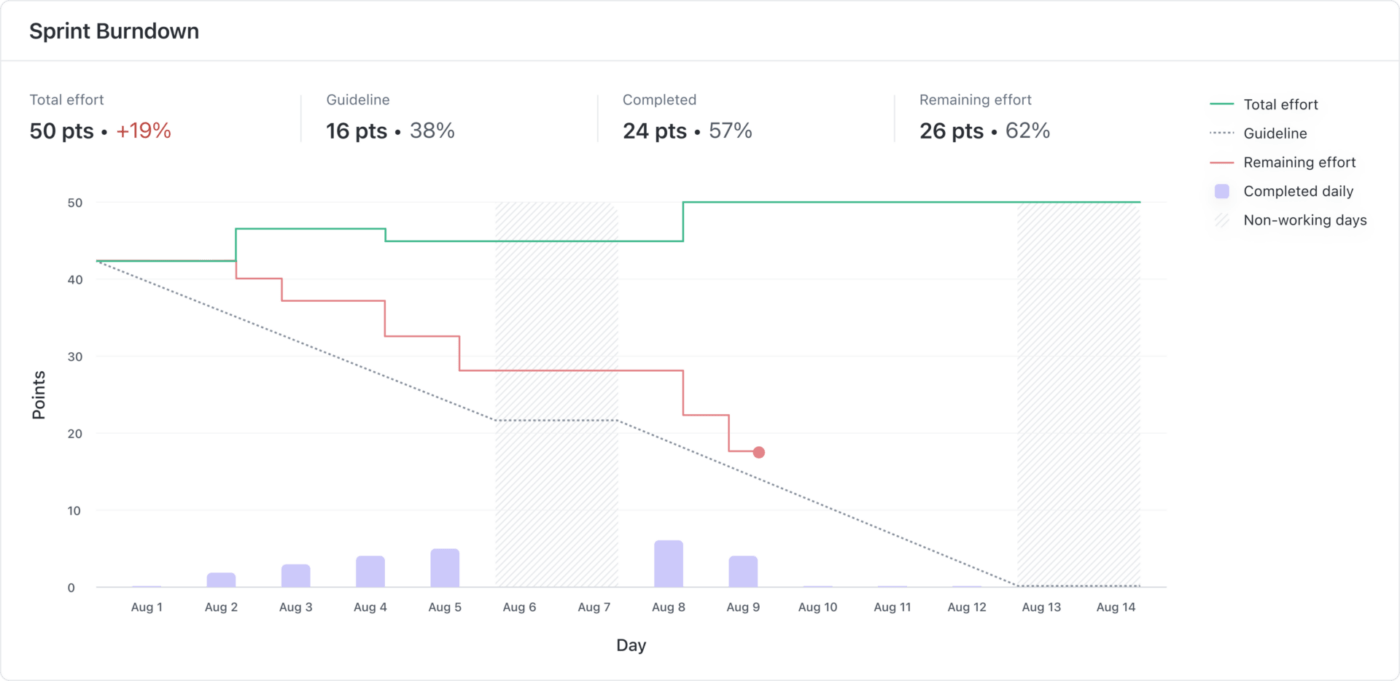
يمكن أن يساعدك المخطط الهبوطي في بطاقات تقارير سبرينت الخاصة ب ClickUp في التعمق في بياناتك للحصول على تحليل أكثر تعمقًا
- السرعة: يمكن عرضها على شكل رقم أو مخطط يوضح متوسط حجم العمل المنجز في كل سباق (على سبيل المثال، نقاط القصة في اليوم). يساعد ذلك على تقييم قدرة فريقك، والتنبؤ بالأداء المستقبلي، وكذلك تحديد مجالات تحسين الكفاءة

قم بقياس متوسط إنجاز عملك في كل سباق سريع في ClickUp لوضع تقديرات أفضل لسباقات السرعة المستقبلية.
- وقت الدورة: غالبًا ما يتم تصوره على شكل مخطط أو رسم بياني، ويوضح متوسط الوقت المستغرق لإكمال عنصر العمل (على سبيل المثال، القصة). يساعد في تحديد الاختناقات في سير العمل، وتحسين إدارة المهام، وتحسين كفاءة الفريق بشكل عام

تمنحك لوحات المعلومات المؤتمتة في ClickUp رؤية ثرية لتقدم الفريق وقدراته وغير ذلك الكثير.
- زمن الدورة: يعرض هذا الوقت الإجمالي من بدء عنصر العمل إلى اكتماله وإصداره. إنه أمر بالغ الأهمية لتحديد التأخيرات في التسليم، وتحسين عمليات الإصدار، وتحسين وقت الوصول إلى السوق
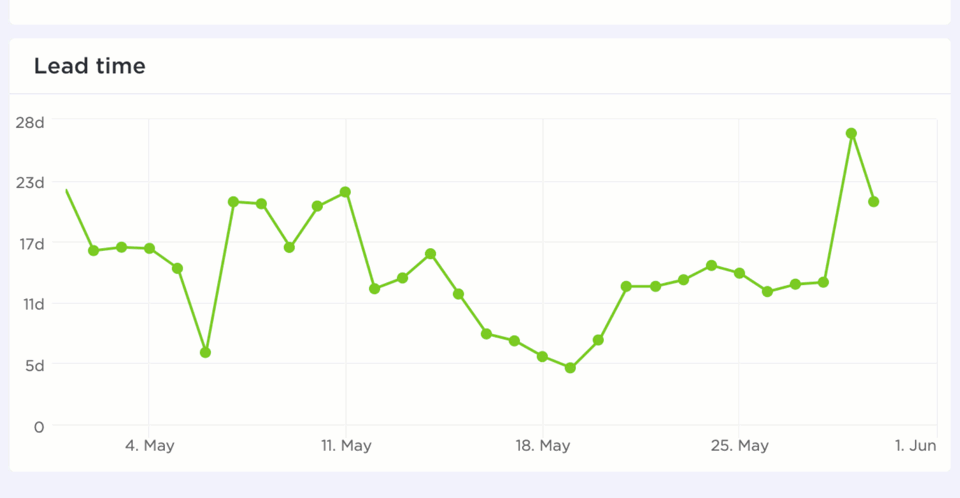
باستخدام ClickUp، يمكنك تتبع المدة التي يستغرقها إكمال المهام من وقت إنشائها وبدء تشغيلها
- التجارب: غالبًا ما يتم تقديمها كقائمة أو لوحة كانبان، وهي تساعد في تتبع المشكلات المحددة التي تعيق التقدم، والفرق المسؤولة، وحالة الحل. كما أنها تعزز الشفافية بشأن العوائق وتسهل التدخل والحل في الوقت المناسب، وتضمن التنفيذ السلس للسباق بشكل عام
- رؤى استرجاعية: تتضمن هذه الرؤى النتائج الرئيسية وعناصر العمل وتحديثات التقدم من عمليات استرجاع أحداث السباق السابقة. تشجع عمليات إعادة النظر على التعلم المستمر، وتعزز التفكير، وتساعدك على تنفيذ التحسينات بناءً على التجارب السابقة. يمكنك أيضًا استخدام قوالب مثلقالب العصف الذهني للعصف الذهني الخاص ب ClickUp's Sprint Retrospective لتجميع الرؤى من السباق السريع المكتمل.
استخدم قالب ClickUp Sprint Retrospective هذا من أجل إعادة تجميع الرؤى المكتسبة من أجل تخطيط المزيد من سباقات السرعة
تعمل لوحات المعلومات الرشيقة على ترقية إنتاجيتك وأدائك من خلال رؤى في الوقت الفعلي وبيانات قابلة للتنفيذ لتحسين رحلتك الرشيقة. بينما تقوم بتتبع المقاييس الأساسية مثل السرعة ووقت الدورة ووقت الإنجاز ووقت التنفيذ، لا تنسَ تخصيص مقاييسك لتعكس سير عملك أو ديناميكيات فريقك الفريدة.
وبالإضافة إلى ذلك، تساعدك لوحات المعلومات على مراقبة الاتجاهات في صحة سباق السرعة والمقاييس الرئيسية بمرور الوقت وتسليط الضوء على مجالات التحسين. يمكنك تحليل بيانات صحة السباق السريع وبيانات الإنجاز لضبط النطاق المستقبلي و تخصيص الموارد ن للحصول على الأداء الأمثل.
كيفية إنشاء لوحة تحكم رشيقة ## كيفية إنشاء لوحة تحكم رشيقة
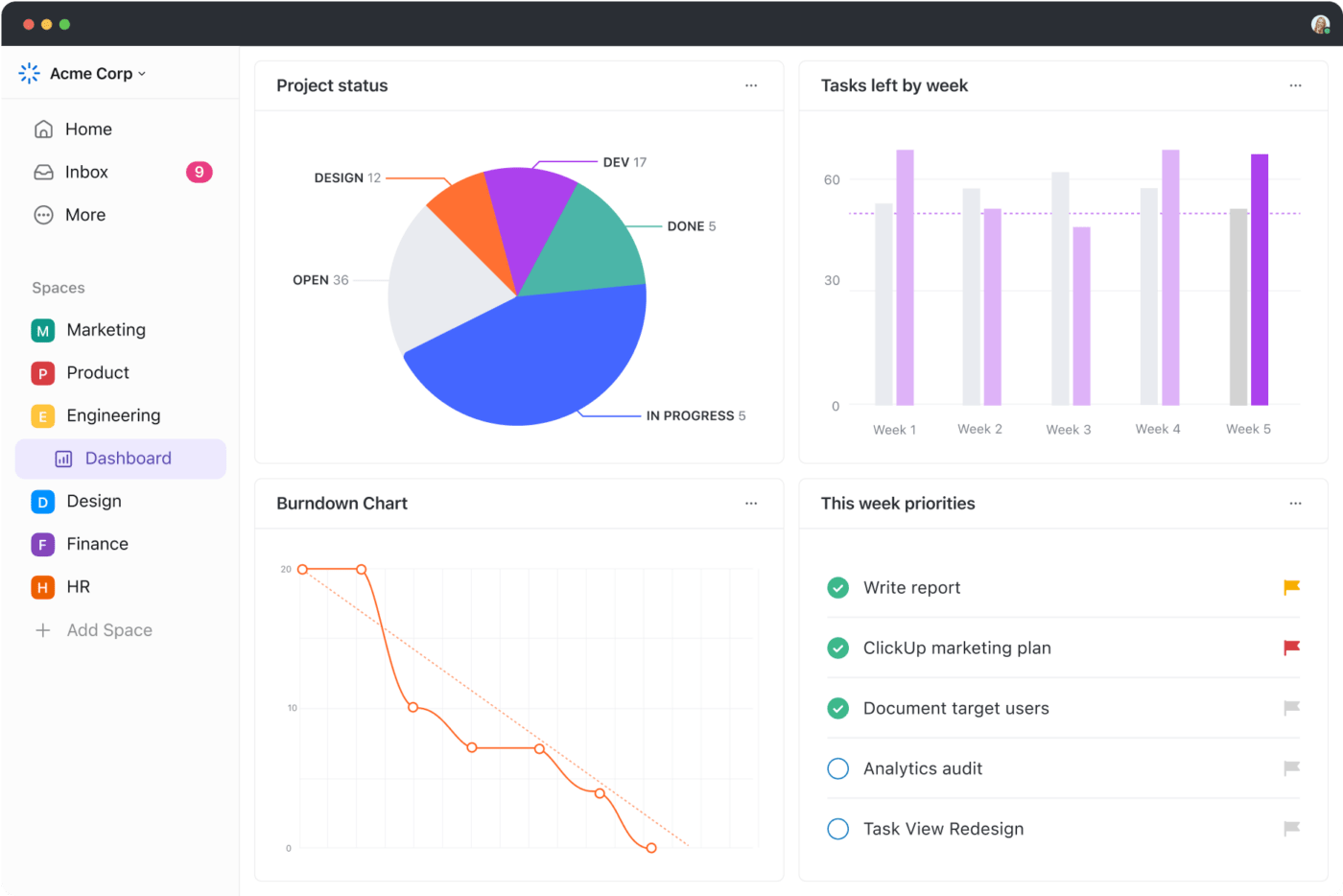
توفر لوحات المعلومات في ClickUp 3.0 لفرق العمل الرشيقة ومديري المشاريع عرضًا سريعًا للمهام والأولويات المتبقية لكل عضو من أعضاء الفريق خلال الأسبوع، بالإضافة إلى مخططات تفصيلية للإنجاز والتراجع
استخدم هذا الدليل المكون من سبع مراحل كلما أردت إنشاء لوحة معلومات رشيقة ذات ثقافة تعتمد على البيانات:
المرحلة 1: حدد أهدافك
- ما هي المعلومات المحددة التي تريد تتبعها ولماذا؟ (على سبيل المثال، تحسين معدل إكمال العدو، وتحديد الاختناقات)
- قم بمواءمة أهدافك مع عناصر سكروم الحاسمة (على سبيل المثال، مخططات الإنهاك لتقدم العدو السريع)
- ضع في اعتبارك احتياجات أدوار الفريق المختلفة (على سبيل المثال، يركز المطورون على المهام الفردية، ويتتبع مالك المنتج الرؤية العامة)
يساعدك قالب إدارة Agile Scrum من ClickUp على تتبع المهام وتحسين سباقات السرعة والحفاظ على اتساق سير العمل
المرحلة 2: اختر الأداة المناسبة
- اخترأداة للوحة المعلومات معقوالب سكروم متوافقة مع أنظمة إدارة المشاريع ومصادر البيانات الموجودة لديك. يتبادر إلى الذهن هنا ClickUp؛ يمكنك أيضًا استخدامقالب إدارة سكروم الرشيقة من ClickUp لمساعدة الفرق على التعاون بشكل أفضل خلال سباق السرعة.
- ضع في اعتبارك ميزات مثل قابلية التخصيص والتحديثات في الوقت الفعلي والتكامل مع الأدوات الأخرى
- تقييم سهولة الاستخدام للمستخدمين التقنيين وغير التقنيين على حد سواء
المرحلة 3: حدد المقاييس ذات الصلة
- ابدأ بالنواةالمقاييس الرشيقة مثل السرعة، ووقت الدورة، والوقت المستغرق، ومعدل الإنهاك
- أضف مقاييس مخصصة خاصة بلوحة معلومات المشروع (على سبيل المثال، معدل العيوب، تغطية الاختبار)
- تأكد من أن المقاييس قابلة للقياس ومفهومة ومتماشية مع أهدافك
المرحلة 4: التصميم من أجل الوضوح
- تحديد أولويات المقاييس الرئيسية للرؤية الفورية
- استخدم عناصر تصور واضحة للبيانات مثل المخططات والرسوم البيانية والمقاييس
- تجنب الإفراط في تحميل المعلومات - اجعلها موجزة وقابلة للتنفيذ
- السماح بالتخصيص بناءً على التفضيلات الفردية

إنشاء لوحات معلومات مفصلة في ClickUp وإضافة بطاقات بسهولة لعرض التقدم المحرز في نقاط العدو، والمهام لكل حالة، والأخطاء لكل عرض
المرحلة 5: التكامل مع البيانات الحالية
- قم بتوصيل لوحة المعلومات بأدوات إدارة مشروعك وأنظمة تتبع الأخطاء ومنصات التحكم في الإصدارات
- ضمان تحديث البيانات تلقائيًا للحصول على رؤى في الوقت الفعلي
- تقليل الإدخال اليدوي للبيانات لتقليل الأخطاء وتوفير الوقت
المرحلة 6: تدريب فريقك
- اشرح الغرض من لوحة المعلومات وكيف تفيد الفريق
- توفير التدريب على تفسير المقاييس واستخدام ميزات لوحة المعلومات
- تشجيع المشاركة الفعالة والتغذية الراجعة من أجل التحسين المستمر
المرحلة 7: التتبع والتنقيح والتكرار
- راقب لوحة التحكم الخاصة بك بانتظام وحلل الاتجاهات
- تحديد مجالات التحسين وتعديل المقاييس أو التصورات وفقًا لذلك
- شجّع مناقشات الفريق واستخدم البيانات لاتخاذ قرارات مستنيرة
## نصائح لإدارة لوحة معلومات رشيقة
فيما يلي بعض النصائح لإدارة لوحة معلومات رشيقة بفعالية:
1. تشجيع عقلية الملكية المشتركة
تعامل مع لوحة المعلومات كأداة للفريق، وليس كمشروع فردي. أشرك الجميع في المناقشات والتعليقات وجهود التحسين.
تناوب ملكية لوحة المعلومات بين مديري المشاريع و أصحاب المصلحة في المشروع بشكل دوري لتعزيز وجهات النظر المتنوعة حول أنشطة المشروع ومنع انغلاق المعلومات.
2. إزالة الغموض عن بيانات فريقك
نظّم ورش عمل أو دورات تدريبية منتظمة لشرح الغرض من لوحة التحكم، ومدى أهمية المقاييس وكيفية تفسيرها بفعالية.
عزز ثقافة تعتمد على البيانات حيث يشعر الجميع بالراحة في استخدام المعلومات ومناقشتها.
3. إضفاء الطابع الشخصي على التجربة
اسمح لأعضاء الفريق بتخصيص لوحات معلومات الفريق الخاصة بهم بالمعلومات والمقاييس والتصورات ذات الصلة الخاصة بأدوارهم ومسؤولياتهم. وهذا يعزز الملكية والتفاعل مع البيانات.
4. تحفيز المحادثة
حدد وقتًا مخصصًا لمناقشات الفريق حول لوحة المعلومات.
قم بتحليل الاتجاهات وتحديد العوائق وطرح الحلول معًا. شجع التواصل المفتوح ووجهات النظر المتنوعة.
5. العمل، وليس مجرد الملاحظة
لا تدع البيانات تقف مكتوفة الأيدي. بدلاً من ذلك، ترجم ما تعلمته إلى خطوات قابلة للتنفيذ.
استخدم الرؤى في تخطيط سباقات السرعة وتخصيص المهام وتحديد مجالات التحسين في عملية التطوير.
6. احتفل بالقرارات المستندة إلى البيانات
قم بتقدير ومكافأة أعضاء الفريق الذين يستفيدون من لوحة المعلومات لاتخاذ قرارات مستنيرة تفيد المشروع. وهذا يعزز قيمة استخدام البيانات ويشجع على المشاركة المستمرة.
7. احتضان الملاحظات
اطلب بانتظام الحصول على تعليقات من فريقك حول فعالية لوحة المعلومات.
على سبيل المثال، اسألهم عن المعلومات الناقصة والميزات التي تحتاج إلى تحسين
ثم استخدم هذه الملاحظات لتكرار لوحة المعلومات وتحسينها باستمرار لتلبية احتياجات فريقك بشكل أفضل.
8. حافظ على تحديثها
تأكّد من دقة البيانات وتحديثها من خلال التحديثات التلقائية والتحديثات المنتظمة.
لا تدع تأخر البيانات في الوقت الفعلي يبطئ عملية اتخاذ القرارات المستنيرة.
9. فكّر فيما وراء لوحة المعلومات
ادمج لوحة القيادة مع أدوات إدارة المشاريع الأخرى ومصادر البيانات لإنشاء رؤية شاملة لصحة المشروع وأدائه.
هذا يتجنب المعلومات المنعزلة ويعزز التعاون متعدد الوظائف.
10. اجعلها ممتعة
قم بتلعيب التجربة! أدخل المنافسة الودية أو أنظمة المكافآت بناءً على استخدام لوحة المعلومات أو الإنجازات المستندة إلى البيانات. هذا يمكن أن يجعل الغوص في المقاييس الفعلية والمتوقعة أكثر جاذبية ومتعة.
## ClickUp يعزز كفاءة فريقك الرشيق
تتطلب إدارة المشاريع الرشيقة منصة تتكيف مع منهجيتك، وليس العكس. ClickUp هي المنصة المثالية لإدارة المشاريع التي تعزز إنتاجية فريقك من خلال لوحات المعلومات الرشيقة.
استخدم مجموعة أدوات وميزات ClickUp القوية لدعم مختلف الأساليب والعمليات الرشيقة بسلاسة. إليك كيف برنامج ClickUp Agile لإدارة المشاريع الرشيقة يعمل
وجهات نظر قابلة للتكيف
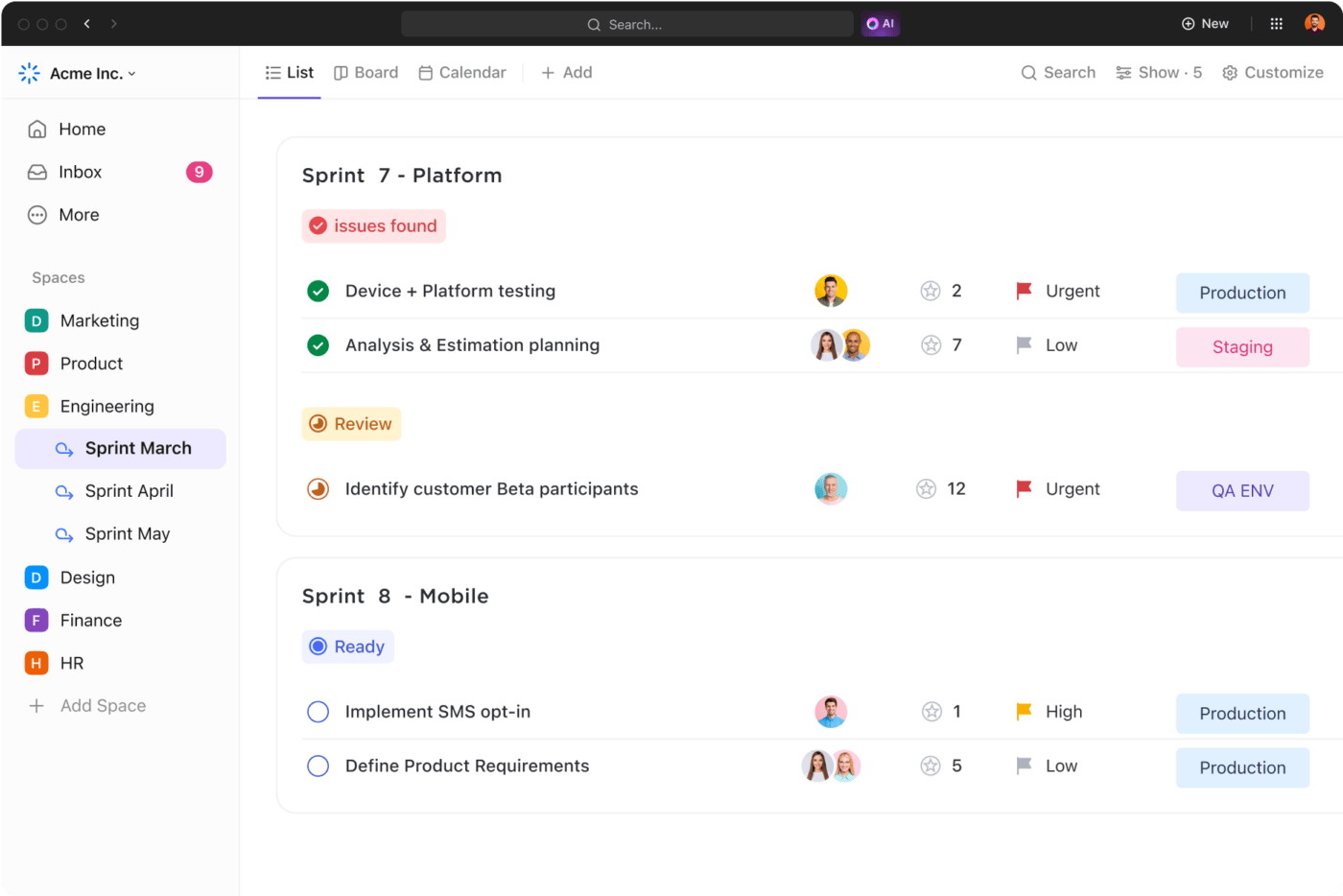
احصل على رؤى سريعة حول سباقات السرعة لفرقك باستخدام طريقة عرض قائمة سبرينت ClickUp Sprint List
لوحات كانبان: تصور سير العمل باستخدام بطاقات مهام السحب والإفلات، وهي مثالية لمنهجيات سكرم وكانبان
طريقة عرض البصمة: تنظيم العمل في تكرارات ذات مربعات زمنية، وتتبع التقدم المحرز باستخدام مخططات ومخططات التقادم السريع، وإدارة الأعمال المتراكمة المتراكمة بكفاءة
عرض القائمة: تحديد أولويات المهام باستخدام انقر فوق طرق العرض ' مواعيد نهائية وتبعيات واضحة، مناسبة للنهج الرشيق والشلال
مرونة التخصيص

إضافة حقول مخصصة مطلوبة إلى المهام والقوائم في ClickUp لضمان أن تكون الفرق على نفس الصفحة وتعمل من نفس طريقة العرض
مهام سير عمل قابلة للتخصيص: تصميم مهام سير عمل مخصصة تتماشى مع ممارساتك الرشيقة واحتياجات فريقك المحددة
لوحات المعلومات القابلة للتخصيص: قم بإنشاء لوحات معلومات مخصصة لوحات معلومات ClickUp مع المقاييس وعناصر تصور البيانات ذات الصلة عن طريق إضافة عناصر واجهة مستخدم لتصور حالة المهمة وبيانات السباق السريع وأهداف الفريق وما إلى ذلك.
حقول مخصصة: التقط نقاط بيانات محددة خاصة بمشاريعك ومديري المنتجات وسير العمل باستخدام برنامج ClickUp لإدارة المنتجات
تكاملات قوية
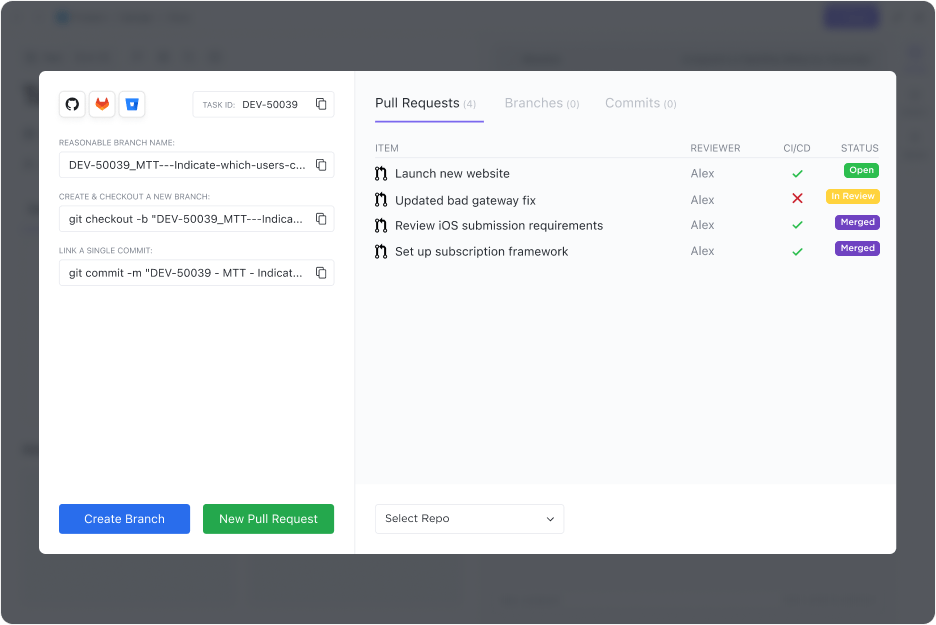
تجنب التنقل بين المنصات وإنشاء فرع أو طلب سحب جديد ضمن مهمة باستخدام تكامل ClickUp's Github الخاص ب ClickUp
يمكنك أيضًا تكامل ClickUp مع المنصة الشهيرة الأدوات الرشيقة وبرامج المراسلة والتعاون المفضلة لديك. قم بتوصيل ClickUp مع برنامج Jira أو بدائله أو دمج GitHub و GitLab للتكامل المستمر، وتدفق البيانات بسلاسة، والإدارة الموحدة
تحسين الإنتاجية

أتمتة المهام المتكررة للفريق بأكمله باستخدام أداة إنشاء الأتمتة في ClickUp
أتمتة المهام وعمليات سير العمل: تقليل العمل اليدوي عن طريق أتمتة المهام المتكررة التي يتم تشغيلها بواسطة أحداث أو ظروف محددة
مركزية التواصل: التعاون داخل ClickUp باستخدام التعليقات والإشارات والدردشة في الوقت الفعلي، مما يلغي الحاجة إلى منصات تواصل متعددة
الميزات التعاونية

اجمع اتصالات الفريق معًا في مساحة واحدة مع ClickUp Chat وشارك التحديثات واربط الموارد وتعاون دون عناء
التعاون في الوقت الفعلي: تحرير المهام، وترك التعليقات، ومشاركة التحديثات على الفور، مما يعزز توافق الفريق وشفافيته
أدوار الفريق والأذونات: تعيين أدوار وأذونات محددة لأعضاء الفريق بناءً على احتياجاتهم ومسؤولياتهم
تحديد الأهداف وتتبعها: وضع أهداف واضحة لسباقات السرعة والمشاريع، وتتبع التقدم المحرز بشكل مرئي، والاحتفال بالإنجازات معًا من خلال انقر فوق سباقات السرعة
التقارير والتحليلات المتقدمة

لخص بسرعة نشاط المهمة خلال وقت محدد واطرح أسئلة محددة حول مالك المهمة وتاريخ الاستحقاق والتعليقات وغير ذلك الكثير باستخدام ClickUp Brain
إنشاء تقارير: تتبع تقدم المشروع وأداء الفريق والمقاييس الرئيسية باستخدام تقارير ولوحات معلومات قابلة للتخصيص
تحديد الاتجاهات والاختناقات: الحصول على رؤى قيمة من تصورات البيانات لتحديد مجالات التحسين
اتخاذ القرارات المستندة إلى البيانات: استخدم البيانات لتخطيط سباقات السرعة وتخصيص الموارد وتحسين العملية بشكل عام
قم بتحويل عملياتك الرشيقة باستخدام ClickUp
معرفة أين يقف مشروعك وإلى أين تتجه من خلال لوحات المعلومات الرشيقة توضح أهدافك. تأكد من توجيه مشروعك بالرؤى وليس بالتخمين!
أنت بحاجة إلى رؤية في الوقت الفعلي لتعزيز اتخاذ القرارات المستندة إلى البيانات عبر الفرق. لوحات المعلومات الرشيقة هي مراكز التحكم في مهمتك لمقاييس الأداء ومحددات عنق الزجاجة وأجهزة تتبع المشروع. توقّع التحديات وحسّن سير عملك وحسّن أيضًا عملياتك باستمرار مع تحقيق أهدافك بشكل أسرع.
بالنظر إلى المستقبل، يبدو مستقبل لوحات المعلومات الرشيقة واعداً. ستتيح إمكانات الذكاء الاصطناعي المتقدمة وقدرات التعلم الآلي التحليلات التنبؤية للحصول على رؤى استباقية. بالإضافة إلى ذلك، فإن التكامل مع الجيل التالي أدوات التطوير ومنصات التشغيل الآلي ستعمل على تبسيط عملية جمع البيانات وتحليلها، مما يقلل من الجهد اليدوي.
والأهم من ذلك أن التركيز على المنهجيات الرشيقة سيتحول نحو لوحات المعلومات المخصصة للأدوار والتفضيلات الفردية. ومع تطور المنهجيات الرشيقة، ستتطور كذلك اللوحات الرشيقة المرافقة لها.
لكن تذكر أن لوحات المعلومات الرشيقة هي أدوات وشركاء في رحلتك الرشيقة. الاستثمار المتسق والملائم في استراتيجيات الاختبار الآلي من قبل الفريق الهندسي يمكّنك من تحقيق المرونة. جرّب ClickUp، وشاهد سير العمل الرشيق الوصول إلى آفاق جديدة من النجاح. جرّب ClickUp مجاناً الآن!
الأسئلة الشائعة الشائعة
1. ما هي لوحة القيادة الرشيقة؟
تستخدم لوحة القيادة الرشيقة عناصر بديهية لتصور البيانات لتمثيل المقاييس الرئيسية ونقاط البيانات التي توفر رؤى في الوقت الفعلي حول تقدم مشاريع تطوير البرمجيات الرشيقة وصحتها وأدائها.
وهي تعمل كمركز تحكم لفريقك، وتوفر الشفافية وتسهل التعاون، وتوجه عملية اتخاذ القرارات المستندة إلى البيانات.
2. ما هي لوحة معلومات سكروم؟
على الرغم من ارتباطها الوثيق بلوحة تحكم رشيقة، إلا أن لوحة تحكم Scrum توفر رؤى ونقاط بيانات في الوقت الفعلي ذات صلة بإطار عمل Scrum.
إنها أداة مساعدة مرئية لفرق Scrum لمراقبة تقدمهم في سباقات السرعة، مما يساعدهم على البقاء على اطلاع، والتعاون بفعالية، واتخاذ قرارات قائمة على البيانات.
3. ما هي لوحة معلومات السباق السريع؟
لوحة معلومات السبرينت هي نوع محدد من لوحات المعلومات الرشيقة المصممة لتقديم رؤى ونقاط بيانات في الوقت الفعلي تتعلق بتقدم سباق معين ضمن إدارة المشاريع الرشيقة إطار العمل.
وهو يعمل كمركز قيادة مرئي لفريق العدو السريع، مما يتيح لهم مراقبة تقدمهم وتحديد العوائق المحتملة واتخاذ قرارات قائمة على البيانات لتحقيق أهداف العدو السريع.



